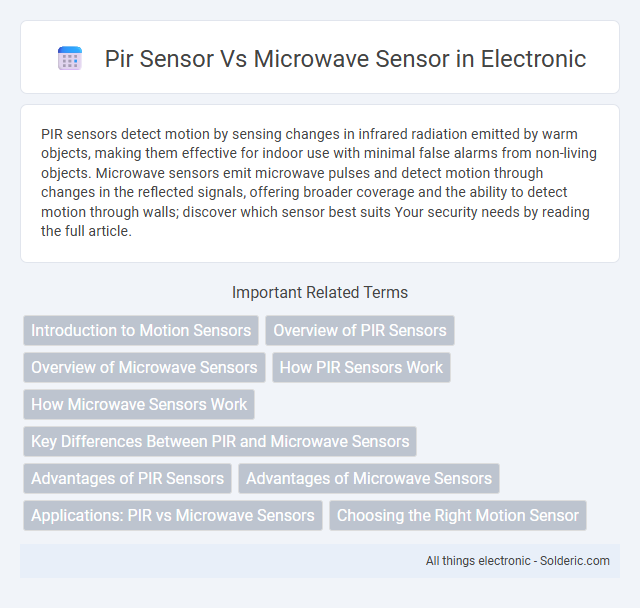PIR sensors detect motion by sensing changes in infrared radiation emitted by warm objects, making them effective for indoor use with minimal false alarms from non-living objects. Microwave sensors emit microwave pulses and detect motion through changes in the reflected signals, offering broader coverage and the ability to detect motion through walls; discover which sensor best suits Your security needs by reading the full article.
Comparison Table
| Feature | PIR Sensor | Microwave Sensor |
|---|---|---|
| Detection Principle | Infrared radiation from body heat | Microwave signal reflection and Doppler effect |
| Range | Up to 7 meters | Up to 15 meters |
| Sensitivity | Medium; limited by line of sight | High; penetrates non-metallic objects |
| False Alarms | Less prone to false alarms | More prone to false alarms (movement of objects) |
| Power Consumption | Low | High |
| Cost | Lower | Higher |
| Typical Applications | Indoor motion detection, security alarms | Through-wall motion detection, automatic doors |
Introduction to Motion Sensors
Motion sensors detect physical movement to enhance security and automation, with PIR (Passive Infrared) sensors sensing infrared radiation from warm objects, while microwave sensors emit microwaves to detect motion through Doppler shifts. PIR sensors excel in energy efficiency and affordability, suitable for indoor environments, whereas microwave sensors offer greater sensitivity and can penetrate obstacles, making them ideal for complex spaces. Your choice depends on the specific application requirements, balancing detection range, installation complexity, and environmental conditions.
Overview of PIR Sensors
PIR sensors detect infrared radiation emitted by warm objects, making them highly effective for motion detection in indoor security systems and automatic lighting controls. They are energy-efficient, cost-effective, and provide reliable performance in stationary environments without being affected by radio frequency interference. Your choice of a PIR sensor ensures accurate presence detection based on body heat, suitable for residential and commercial automation applications.
Overview of Microwave Sensors
Microwave sensors use radio waves to detect motion by emitting continuous microwave signals and measuring the frequency shift caused by moving objects, making them highly sensitive to motion through walls and obstructions. Unlike PIR sensors that detect infrared radiation from body heat, microwave sensors can function effectively in complete darkness and harsh environmental conditions. If you need a sensor with long-range detection and the ability to sense motion through materials, microwave sensors provide a robust solution.
How PIR Sensors Work
PIR sensors detect infrared radiation emitted by warm objects such as humans and animals, making them ideal for motion detection in security and automation systems. They work by measuring changes in the ambient infrared energy when a person moves across the sensor's field of view, triggering an output signal. Your choice of sensor depends on the application, but PIR sensors are typically preferred for their low power consumption and cost-effectiveness in indoor environments.
How Microwave Sensors Work
Microwave sensors emit high-frequency radio waves and measure the reflected signals to detect motion, allowing them to sense through materials like glass or thin walls. Unlike PIR sensors that detect infrared radiation from body heat, microwave sensors use Doppler radar technology to identify movement by changes in the frequency of the returned waves. Your choice between PIR and microwave sensors depends on the detection environment and desired sensitivity, as microwave sensors offer higher sensitivity and coverage area in challenging conditions.
Key Differences Between PIR and Microwave Sensors
PIR sensors detect infrared radiation emitted by warm objects, making them ideal for motion detection through body heat changes, while microwave sensors emit microwave pulses and measure the reflection to detect movement. PIR sensors are typically more energy-efficient and less prone to interference, whereas microwave sensors offer greater sensitivity and can detect motion through certain materials. Your choice depends on the specific environment and application requirements, balancing accuracy, range, and potential false alarms.
Advantages of PIR Sensors
PIR sensors offer significant advantages including low power consumption, making them ideal for battery-operated devices and long-term monitoring applications. They provide reliable motion detection by sensing changes in infrared radiation emitted by warm objects, ensuring accurate presence detection without interference from non-living objects. PIR sensors are also cost-effective and straightforward to install, making them a popular choice for residential and commercial security systems.
Advantages of Microwave Sensors
Microwave sensors offer superior sensitivity and can detect motion through obstacles such as glass, wood, and thin walls, making them ideal for security and automation systems. These sensors operate by emitting microwave signals and measuring their reflections, allowing them to track even subtle movements with high accuracy. Their ability to function effectively in various lighting and environmental conditions provides a significant advantage over PIR sensors in complex detection scenarios.
Applications: PIR vs Microwave Sensors
PIR sensors excel in residential and commercial security systems by detecting infrared radiation from human movement, making them ideal for indoor motion detection and energy-efficient lighting control. Microwave sensors are preferred in industrial environments, automatic door openers, and wide-area surveillance due to their ability to detect motion through walls and non-metallic objects, offering higher sensitivity and coverage range. Each sensor's application is optimized by considering factors like environment, detection range, and interference susceptibility.
Choosing the Right Motion Sensor
PIR sensors detect motion based on infrared heat signatures, making them ideal for indoor environments with clear line-of-sight and minimal obstructions. Microwave sensors emit electromagnetic waves that penetrate materials, enabling detection through walls and obstacles, suitable for larger or complex spaces. Selecting the right motion sensor depends on factors like installation location, environmental conditions, sensitivity requirements, and potential interference sources.
pir sensor vs microwave sensor Infographic

 solderic.com
solderic.com